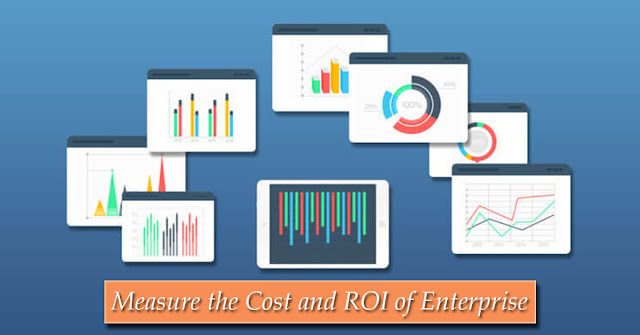How to Measure the Cost and ROI of Enterprise Application?
ROI is considered to be one of the most important measures which can evaluate the ongoing success and contributions of an enterprise application.
But still, measuring how ROI applies to a mobile initiative can be difficult.
You are required to have thorough management and reporting tools in order to measure the cost and ROI of the enterprise apps.
There is a requirement of continuous monitoring of app metrics as well as action plans that can help to stem from each report.
Have a look at the basic formula for measuring the ROI of any project:
ROI = (Gain from Investment – Cost of Investment) / Cost of Investment (expressed as a percentage)
If in case your organization is already having an application or planning to build a new one, read this post carefully as this will help for measuring and evaluating ROI for your imitating, and estimating if the investment is worthwhile.
But still, measuring how ROI applies to a mobile initiative can be difficult.
You are required to have thorough management and reporting tools in order to measure the cost and ROI of the enterprise apps.
There is a requirement of continuous monitoring of app metrics as well as action plans that can help to stem from each report.
Have a look at the basic formula for measuring the ROI of any project:
ROI = (Gain from Investment – Cost of Investment) / Cost of Investment (expressed as a percentage)
If in case your organization is already having an application or planning to build a new one, read this post carefully as this will help for measuring and evaluating ROI for your imitating, and estimating if the investment is worthwhile.
COST OF INVESTMENT
Firstly, let’s take a look at how much an enterprise application might cost you.
how much does an enterprise application cost
1. Cost of development – $50,000-$120,000
Let's suppose you are looking for building a custom medium-sized app by implementing a lean approach to app development through which a minimum viable product is brought first to eliminate wasted resources, a budget for development should be set between $50-$120,000.
2. Maintenance cost – $2000-$7000/yr
Bugs are considered to be the part of software development and this is the hardest concepts to grasp for many of our clients. How often have you received an update for an app on your phone and one of the reasons given is “Bug Fixes”?
Even many of the updates to the core operating systems in Apple and Android devices are to fix bugs.
There is a need for regular maintenance as bugs are a normal part of releasing an app and can arise because of the large requirement for integration across many versions of systems and platforms.
If you are doing the process of maintenance, always take into consideration that the app remains fast, powerful and run smoothly.
This can charge $2000-$7000 per year, which will include OS updates, API changes, and other 3rd party software and hardware changes/releases which may impact your app’s systems.
How much the complexity of the system is there as well as how your app integrates with other systems makes the cost and the necessity of these maintenance activities.
3. Cost of updates – $5000-10,000 each update
For example, you are doing the process of updating regularly based on user feedback and to increase customer engagement, you should budget between $5000-$10,000 for each update cycle.
As the size of updates are different as some are bigger than others, so usually updates will be quoted on an individual basis based on the requirements.
It’s incredibly important for the lifetime value of an application for it to be updated regularly. This keeps apps relevant and valuable to their users.
80% of enterprise applications fail to engage users, and one of the biggest reasons for this is stale content.
Fixing of bugs not just based on the regular updates, it is also mandatory on the part of enterprises that they should release updates that make apps run faster, smoother and more intuitively based on user metrics and feedback.
Have a look at Sensor Tower’s analysis of the top 25 apps on the iOS app store for how often they release updates.
They found that the average time between updates was 30 days, with many apps updating more frequently than this.
Of course, this type of update frequency is not required for most enterprise apps, especially if they are for internal use, but the point is that apps are like any other part of your business – If you let them become stagnant your user base will get bored and drop off.
Yes, it is common that the update frequency is not at all mandatory for most enterprise apps, especially in the case if they are for internal use.
Now that you have benchmarks for the cost of your mobile application investment, let’s look at how you will measure the benefits.
GAIN FROM INVESTMENT
Step 1: Identify your application’s goal
There is a specific formula or a system for each and every organization which may be already in place in order to measure the ROI of a new initiative, and mobile should be no different.
That being said, not all metrics are created equal, and organizations should be aware of which KPIs are most indicative of an application’s success.
There is no need to have a look at 300 KPIs in order to measure an app’s success. 3-4 meaningful metrics could even be enough!
The kind of valuable behavior which is being attempted by you totally depends on your app’s unique vertical and purpose.
Identify the core aim of the app itself – what business challenges does it seek to solve?
Here is the most common reason being founded by us for building an enterprise application fall under the following broad categories.
Improved internal inefficiencies – For example, automating processes that previously required time-consuming manual tasks.
Improving employee productivity, faster communication or collaboration
Increasing sales – Using mobile as an additional touch point to engage customers
Step 2: Choose KPIs that reflect that goal
choose KPIs that reflect your app goals
Does not matter that, what actually the purpose of the application to your company’s overall strategy, let’s determine the most important 5-10 metrics for reaching them.
Your metrics should always reflect the KPIs you are trying to reach by measuring them in the first place.
Don’t measure what won’t add value (or future action) to your organization.
Let’s take a look at those 3 broad categories again and explore some common metrics which will help you assess the ROI of the activity.
INTANGIBLE KPIs
These benefits are so tangible or difficult that cannot be measured on a numeric level.
You cannot always quantify the benefits of developing an application, but they can’t be overlooked either – they are often the most compelling components of the business case.
These should still be included in the evaluation of an application’s performance, but not within the ROI calculation itself because they can’t be quantified.
These may include:
Demonstrating that you are a forward-thinking, relevant and modern company which is committed to never-ending improvement
- Serving as a key point of difference to your competitors
- Increased customer satisfaction (demonstrated through verbal or anecdotal feedback)
- Ability to offer improved customer service and support
- Improving customer sentiment or employee morale
- And don’t underestimate the cost of procrastination.
Step 3: Calculate, evaluate, and improve
calculate ROI for enterprise applications
As soon as you get the estimated or actual cost (development, maintenance, and updates) and benefits (taken from a handful of KPIs you identified as most important), you can begin your ROI calculation.
There is a requirement for your organization for setting benchmarks for the yearly return on investment of your application.
There are various mobile initiatives who don't see a return within 2 years of investment, but they may see greater increasing returns year on year.
For example, a large-scale internal application that completely changes existing processes may not see a return for 3 years, but realises 15% increased revenue 4 years after development, and then 25% the year after that, increasing year on year as it matures.
Alternatively, your application may see diminishing returns if it fails to engage and retain users over its lifetime.
The ROI number will speak for itself!
Want to achieve ROI within 2 years of deploying your mobile initiative?
Follow the 7 best practices of the top mobility leaders – these enterprises that have seen ROI on mobile initiatives within 2 years of launch.
For more information follow: https://www.graymentechnologies.com




Comments
Post a Comment